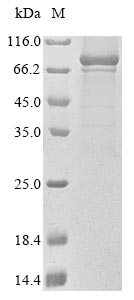Recombinant Human MGAT4A comes from a mammalian cell system and covers amino acid region 93-535. The protein features dual tags—an N-terminal 10xHis-tag and a C-terminal Myc-tag—which help with purification and detection. SDS-PAGE analysis shows the protein maintains a purity level above 85%, making it suitable for research applications. This recombinant protein is intended for research use only and doesn't include the complete sequence.
MGAT4A appears to play an important role in N-glycan branching, a process that seems crucial for proper protein folding and function. The protein acts as a glycosyltransferase, adding N-acetylglucosamine to specific mannose residues on glycoproteins. This modification is likely vital for cellular processes like cell-cell communication and protein stability. That's why MGAT4A has become a protein of interest in studies examining glycosylation pathways and related disorders.
Potential Applications
Note: The applications listed below are based on what we know about this protein's biological functions, published research, and experience from experts in the field. However, we haven't fully tested all of these applications ourselves yet. We'd recommend running some preliminary tests first to make sure they work for your specific research goals.
Based on the provided information, the recombinant MGAT4A protein has a higher probability of correct folding due to the mammalian expression system, which can provide proper eukaryotic folding environments and potential post-translational modifications important for glycosyltransferase function. However, the protein is a partial length (93-535aa) and contains dual tags (N-terminal 10xHis and C-terminal Myc), which may affect its structural integrity. The C-terminal Myc tag is particularly concerning as it may interfere with the catalytic domain or protein folding. While mammalian expression systems generally support proper folding, the partial nature (missing N-terminal cytoplasmic/transmembrane domains) and dual tagging mean the protein's bioactivity cannot be guaranteed without experimental validation. The purity >85% indicates some impurities that could include misfolded species. Without enzymatic activity validation, the protein's functional status remains uncertain.
1. Glycosyltransferase Enzyme Characterization Studies
This recombinant MGAT4A can be used for enzymatic studies only if glycosyltransferase activity is experimentally verified. While the mammalian expression system supports proper folding, the partial sequence (lacking the N-terminal transmembrane domain) and dual tags may affect enzyme kinetics and substrate recognition. The C-terminal Myc tag might sterically hinder the active site or affect protein conformation. Before quantitative kinetic studies, validate activity using accepted substrates (e.g., oligosaccharide acceptors) and compare with full-length enzyme standards. The purity of>85% may require further purification for reliable kinetic measurements.
2. Protein-Protein Interaction Studies
The dual-tagged MGAT4A can be used in interaction studies, but detected partners may reflect tag-mediated artifacts rather than biological interactions. The partial sequence (93-535aa) represents mainly the catalytic domain and may lack regulatory regions important for native interactions. For valid results, validate folding first and include rigorous controls (e.g., tag-only proteins, catalytically inactive mutants). The mammalian expression system increases the likelihood of proper folding, but independent confirmation is still necessary.
3. Antibody Development and Validation
This recombinant MGAT4A can generate antibodies, but the dual tagging may result in antibodies that primarily recognize tags rather than MGAT4A-specific epitopes. The partial sequence (93-535aa) may not represent full conformational epitopes of the native protein. For specific antibodies, validate using full-length MGAT4A or confirm recognition of endogenous protein. The purity of>85% is acceptable but not optimal, as contaminants could induce non-specific antibodies.
4. Structural and Biophysical Analysis
The protein is unsuitable for high-resolution structural studies without tag removal and purity improvement. The dual tags introduce flexibility and heterogeneity that hinder crystallography or cryo-EM. The purity >85% is suboptimal for structural work (typically requiring >95%). Biophysical techniques can assess general folding, but for meaningful structural insights, remove tags, increase purity, and validate native conformation through activity assays. The mammalian expression system supports proper glycosylation but cannot overcome tag-induced structural artifacts.
Final Recommendation & Action Plan
To ensure reliable results, first validate the folding and bioactivity of the recombinant MGAT4A through enzymatic activity assays using appropriate sugar nucleotide donors and oligosaccharide acceptors, coupled with structural analysis (e.g., circular dichroism for secondary structure). Given the potential interference from dual tags, consider tag removal via proteolytic cleavage (if cleavage sites are present) and re-purify the tag-free protein for enzymatic and structural studies. For applications like antibody development, use the current protein but validate resulting antibodies against full-length MGAT4A. Always include appropriate controls in experiments, such as tag-free proteins or catalytically inactive mutants, to account for potential artifacts. The mammalian expression system provides advantages for proper folding, but independent validation remains essential for quantitative applications.






